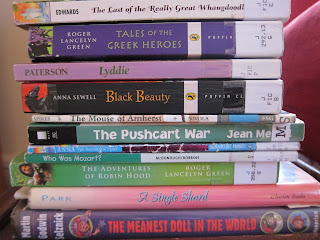As I've been reading classic children's books to my daughter, I've noticed a theme that doesn't come up much in modern children's literature: the healing, even redemptive, power of nature. In book after book, children find happiness, peace, self-confidence, spiritual satisfaction, and their true selves as well as physical healing after finding or living in some special place surrounded by nature. Perhaps a product of or related to the Transcendentalist movement in the United States, epitomized by Henry Thoreau's
Walden, these works emphasize not just nature but self-reliance and solitude. These books also express a belief that there is a significant connection between physical, mental, and emotional health.

In
Heidi, first published in 1880 (perhaps the oldest book I have read to my children!), the title character is happiest when in her mountain home with her grandfather. She spends day after day with her taciturn friend Peter and the goats he herds in the mountain pastures. In significant contrast to today's children, she needs nothing more to amuse her - not toys, not books, and certainly not electronic devices. She is content just frolicking with the goats, picking flowers, and admiring the view. She is not asocial however, and her relationships with her grandfather, Peter, and especially Peter's grandmother are vital to her. When she is taken to live in Frankfurt to be the companion for the wheelchair-bound Clara, she languishes, both mentally and physically, in spite of the fact that she enjoys Clara's company. Of course, in the end, the mountains prove healing not just for Heidi but for Clara's doctor, whose grief over his daughter's death is eased by his visit there, and for Clara, who ultimately regains the ability to walk. Interestingly, Heidi's spiritual awakening comes not in the mountains but in Frankfurt, encouraged by Clara's Grandmamma, who urges her to pray and to believe that even if things do not turn out the way she originally wanted, God has a plan that will eventually reveal itself. Nonetheless, it is the mountains which are portrayed as the source of healing.


In
The Secret Garden, as the orphaned Mary Lennox tends the abandoned garden she has discovered, she tends her own spirit and body, and is transformed from a sickly, contrary child who cannot or will not even dress herself to a healthy, happy one who is self-reliant and resourceful. As she spends time outdoors, she becomes "wider awake every day." In a parallel to
Heidi, a wheelchair-bound child (here, Mary's cousin Colin) who also participates in restoring the garden, regains the ability to walk. Similarly, in Julie Andrews Edwards's
Mandy, a more recent work first published in 1971, the title character (also an orphan) finds peace and happiness in tending a secret garden and turning a secret cottage into a home of her own. As their gardens blossom, so do they.
A move to a country farm also results in the transformation of Elizabeth Ann in
Understood Betsy from a doted-on, supposedly sickly, nervous child into a confident, independent and happier one, as I wrote
here. When her Aunt Frances must leave her with relatives at a Vermont farm, Elizabeth Ann (whom her Vermont relatives immediately and familiarly address as Betsy), discovers that she is neither nervous nor frail nor incompetent. New experiences, including the simplest of tasks such as getting out of bed on her own, to other, more challenging ones, such as making butter and walking to school alone on her first day, push her to become more independent. To her surprise, she finds these experiences not only empowering but fun. The girl Aunt Frances comes back to retrieve is very different from the one she left. It is the farm and nature which make the difference.
It is interesting how all these children enjoy spending time alone. They each have friends, relatives, or mentors, but they spend a significant amount of time by themselves - and like it. While today's books often address how to navigate friendships, bullying, and other relationships, these books focus on children's internal life. It is not their relationships which nurture their emotional and physical growth (although they help), but nature which does most of the work. Then again, these fictional children have the luxury (or hardship, depending on your perspective) of lots of leisure time, as they either do not attend school, or attend it for many fewer hours and days per year than children do now.
It is also noteworthy that not one of these children lives with her parents. Is this just a plot device? These children, orphans or pseudo-orphans, are somewhat forced into solitude and introspection. It would be nice to see a book with the same themes featuring a child with her nuclear family intact.
Do you think these books still speak to children? Are they too dated? Has the idea of nature as a force for healing (both physical, mental, and emotional) been eclipsed by modern medicine, for better or for worse? Are the ideas of living somewhere remote or undeveloped, or of nature as a redemptive force, too foreign to our plugged-in, urban and suburban children or do they open a whole new world to them? My 7-year-old city girl has loved all of these books (except for
The Secret Garden, which she has not yet read and which I am giving her for her next birthday), but is she typical?
Can you think of any other classics that would fit in this category? Finally, can you think of any contemporary children's books with similar themes?



























